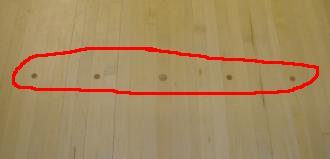 Targeting Aids
Targeting Aids
There are several aids on a tenpin bowling lane that can be used to help you improve your accuracy. Some of the articles on this site use these as reference points from which to work. Some people also know these by other names such as dots, spots, rangefinders, darts etc., so to make life easier, I am going to explain what and where they are and set out the terms I use on this site.
To ensure the sport is fair, every official tenpin bowling lane everywhere in the world has to conform to a very rigid set of specifications which, once we know, we can use to make mathematically based adjustments, which is the reasoning behind the systems you will find on this site.
Dots
First of all, to help us line up in the same place each time, there are two sets of dots on the approach:

Just be careful with these dots as some centers have 5 dots on each line while others have an extra dot on each end, making 7. Also, the set of dots closest the foul line are always 12 feet from the foul line. The rearmost set of dots an be between 14 and 15 feet from the foul line depending on the length of the approach which could affrect you if you are visiting another center.
These dots are also repeated just before the foul line so you can see where your foot stopped (Yes, as you improve you will need to note where your foot finished - who said bowling was not a mental sport).
Just to give you an idea of the placing of the dots, the centermost dot (normally the largest) is on the middle board which is in line with the headpin on the lane. Each dot is then five boards away from it's neightbour. Each board is approximately one inch wide and therefore we can say that the dots are five inches apart.
Arrows
The next thing to notice on a lane is the "arrows" which are between 15 and 17 feet down the lane:

For our purposes, we can say that these are 15 feet away, or one quarter of the way down the lane. On a wood bowling lane, they are just before the "splice", where the hard maple of the "heads" joins the softer pine of the main part of the lane which you can just see in the picture above, the pine boards being darker than the maple.
These arrows line up with the dots on the approach - the middle arrow is on the middle board and each arrow is 5 boards away from it's neighbour, effectively 5 inches again. Therefore a line drawn from the middle dot, through the middle arrow would also go through the middle of the headpin and 5 pin.
The most common target at the arrows, to generate some angle of the ball as it hits the pins is the "second" arrow, counting in from the outside, as shown in the following picture:

The two circles are to show the second arrow for right and left handers - right handers would use the red circled arrow while left handers would use the green circles arrow. Backup or reverse hook bowlers would use the target for the opposite hand, i.e. a right handed backup bowler would normally use the green highlighted arrow to make the best use of the movement of their ball.
These are not the only targeting aids on the lane but they are the main ones, and those most commonly used. If you have not used them before, have a look for them next time you go bowling and see if you can use them to improve your game.